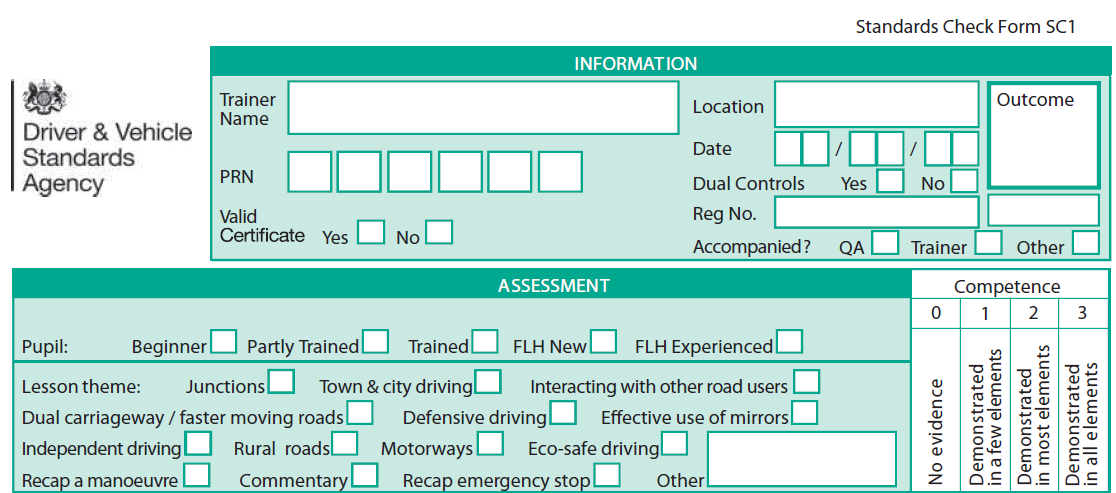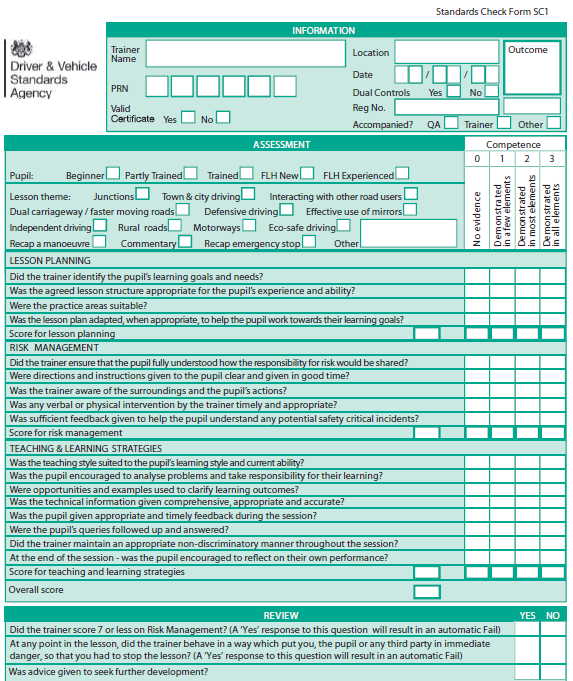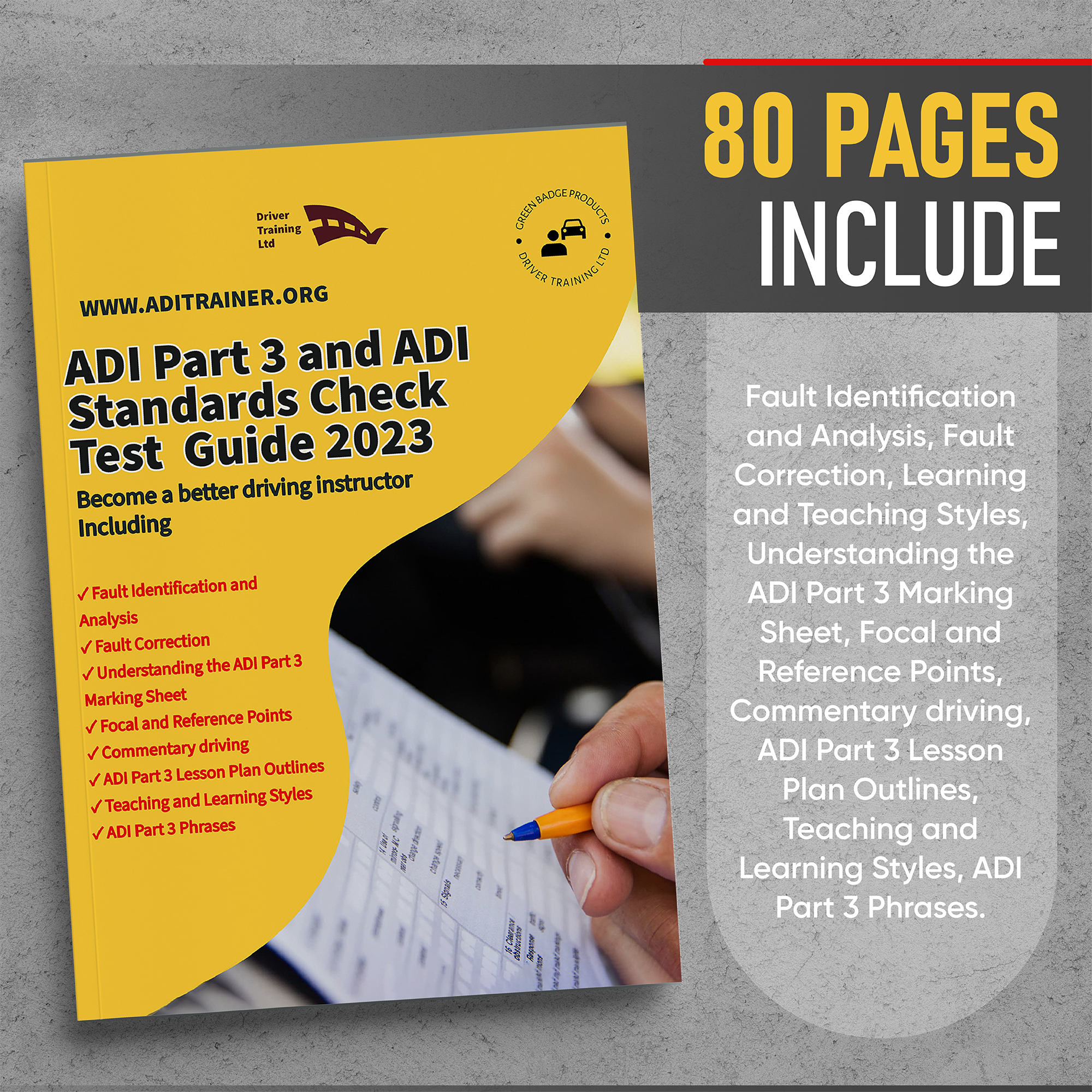ADI Standards Check Marking Sheet Explained
ADI Standards Check Marking Sheet
Here's why understanding the ADI Standards Check marking sheet is crucial:
-
Assessment criteria: The marking sheet outlines the specific assessment criteria against which driving instructors are evaluated during the Standards Check. Familiarizing yourself with these criteria helps you understand what aspects of your instructional abilities are being assessed, ensuring you can focus on meeting those standards during the test.
-
Performance feedback: The marking sheet provides a clear breakdown of the different areas that the examiner assesses, such as lesson planning, risk management, teaching and learning strategies, and more. By understanding the criteria, you can interpret the feedback provided by the examiner more effectively. This enables you to identify your strengths and areas for improvement, helping you enhance your teaching skills and deliver better instruction in the future.
-
Self-evaluation: Studying the marking sheet allows you to assess your own performance and prepare for the Standards Check more effectively. By aligning your instructional techniques and practices with the assessment criteria, you can proactively identify any potential areas of weakness and work on improving them before the test. This self-evaluation helps you present your best performance during the Standards Check.
The ADI Check Test Marking Sheet Explained
This complete guide gives you the confidence and knowledge you need to become a better teacher and provide your students with a thorough understanding of all subjects.
* 80 Pages - Quality printed on glossy 120gsm paper. Each subject is comprehensively covered including understanding the marking sheet, fault identification, Fault Analysis and Pupil Reference Points. The thicker covers ensure durability and ease of use.
* Includes Detailed Instruction - Unlike other ADI Standards Check Test Guides, ours provides a simple but comprehensive explanation of the aspects of taking the ADI Standards Check Test exam.
Including
✓Fault Identification and Analysis ✓Fault Correction ✓Learning and Teaching Styles ✓Understanding the ADI Standards check Marking Sheet ✓Focal and Reference Points ✓Commentary driving ✓ADI Standards Check Lesson Plan Outlines ✓Teaching and Learning Styles
Get yours from our EBAY STORE
Get Yours From our AMAZON STORE

ADI Standards Check Marking Sheet Explained
The top section of the ADI standards check marking sheet, is what the examiner fills in.
It lists your name, the test centre where you are taking the ADI Part 3 test, your personal registration number with the DVSA.
LOG BOOK - This is whether you have the training sheets from YOUR trainer.
At the end of each training session, you should be given notes on what needs to be worked on or strengthened. It is these training records, your examiner will want to see.
TRAINER PRN - This is the personal registration number of your trainer - Your trainers DVSA number - This again is so the DVSA can keep a track of the standard of trainees that a trainer sends for the ADI Part 3
ORDIT - Is your trainer ORDIT registered? - The DVSA only recognise ONE qualification for those it recommends as driving instructor trainers.
ORDIT Registration. - This stands for the Official Register of Driving Instructor Trainers these trainers have been assessed by the DVSA and found to offer the calibre of training for potential driving instructors that the DVSA requires. Having a city and guilds or being advanced driver creditted is not recognised as a sufficient standard by the DVSA only ORDIT registration.
Accompanied - This is not a requirement, but the DVSA does encourage all trainers to attend the ADI Part 3 with their trainees, to hear first hand any debrief, so that they can help the trainee progress further.

ADI Standards Check - Lesson Planning
The ADI Standards Check lesson planning section is of great importance as it evaluates the ability of driving instructors to effectively plan and structure driving lessons. Lesson planning is a critical aspect of instructional delivery, ensuring that learning objectives are met, skills are developed progressively, and learners receive a well-organized and engaging learning experience. Here are key reasons why the lesson planning section of the ADI Standards Check holds significance:
-
Learning objectives: Lesson planning establishes clear learning objectives that guide the instructional process. By setting specific goals for each lesson, instructors provide a sense of direction and purpose to the learning experience. Effective lesson planning ensures that these objectives are relevant, measurable, and aligned with the needs and abilities of the learner driver.
-
Progression and continuity: Lesson planning promotes a structured and progressive approach to skill development. Instructors should demonstrate the ability to design lessons that build upon previously acquired skills, ensuring a logical progression and continuity in learning. Effective planning helps instructors determine the appropriate sequencing of topics and maneuvers, allowing learners to develop their driving skills in a systematic and cohesive manner.
-
Time management: Lesson planning involves effective time management, ensuring that the allocated time for the lesson is utilized efficiently. Instructors need to demonstrate the ability to allocate sufficient time for each element of the lesson, including introductions, practice sessions, review and feedback, and summary. Proper time management ensures that learners receive adequate practice and instruction without feeling rushed or overwhelmed.
-
Adaptability and flexibility: Lesson planning should be adaptable and flexible to accommodate the individual needs and progress of learners. Instructors should demonstrate the ability to make adjustments during the lesson if necessary, such as providing additional practice time, adapting teaching strategies, or addressing specific learner challenges. Flexibility in lesson planning allows instructors to tailor their approach to the specific requirements and learning styles of each individual learner.
-
Integration of theory and practice: Effective lesson planning incorporates a balance between theoretical knowledge and practical application. Instructors should demonstrate the ability to integrate relevant theoretical concepts, road rules, and driving principles into practical driving exercises. This integration enhances learners' understanding of the underlying principles of safe and responsible driving, enabling them to apply theoretical knowledge in real-world driving situations.
-
Resources and materials: Lesson planning involves the selection and utilization of appropriate resources and materials. Instructors should demonstrate their ability to identify and incorporate relevant visual aids, diagrams, handouts, or interactive tools to enhance the learning experience. Well-prepared lesson plans ensure that instructors have the necessary resources at hand to support effective instruction and engage learners.
-
Evaluation and assessment: Lesson planning includes provisions for evaluation and assessment of learner progress. Instructors should demonstrate the ability to integrate formative assessment techniques during the lesson to monitor learner performance, provide constructive feedback, and identify areas for improvement. Effective evaluation helps instructors gauge the effectiveness of their teaching strategies and make necessary adjustments for future lessons.
By excelling in the lesson planning section of the ADI Standards Check, driving instructors demonstrate their ability to design and deliver well-structured, engaging, and effective driving lessons. Strong lesson planning skills ensure that learners receive a comprehensive and progressive learning experience, leading to the development of safe, skilled, and responsible drivers.

ADI Standards Check Risk Management
The ADI Standards Check risk management section is important because it assesses the ability of driving instructors to effectively identify, analyze, and manage potential risks during driving instruction. Risk management plays a crucial role in ensuring the safety of both the instructor and the learner driver. Here are key reasons why the risk management section of the ADI Standards Check holds significance:
-
Safety of learners: Risk management is essential for promoting the safety of learner drivers. During the Standards Check, the examiner evaluates how well the instructor identifies and addresses potential risks that may arise during the driving lesson. This includes assessing the instructor's ability to anticipate hazards, implement appropriate control measures, and effectively communicate safe driving practices to learners. By demonstrating strong risk management skills, instructors contribute to creating a safe learning environment and instilling safe driving habits in their students.
-
Compliance with regulatory standards: The Driver and Vehicle Standards Agency (DVSA) sets specific standards and guidelines for driving instructors to ensure they provide instruction that meets the required safety standards. The risk management section of the ADI Standards Check assesses instructors' adherence to these standards. By evaluating instructors' risk management abilities, the DVSA ensures that instructors are competent in delivering instruction that aligns with legal and regulatory requirements.
-
Preparation for real-world driving: Effective risk management instruction prepares learners for real-world driving situations. By assessing risk factors on the road and providing guidance on how to mitigate those risks, instructors equip learners with essential skills to navigate various driving scenarios safely. The risk management section of the Standards Check evaluates instructors' ability to impart these skills to their students, emphasizing the importance of effective risk assessment and decision-making on the road.
-
Professional development: The risk management section of the Standards Check offers valuable feedback and insights for instructors to improve their instructional techniques. By evaluating instructors' risk management skills, the examiner provides constructive feedback, highlighting areas of strength and areas for improvement. Instructors can utilize this feedback to enhance their risk management abilities, continually develop their teaching practices, and provide a higher quality of instruction.
-
Overall quality of instruction: The risk management section contributes to the overall evaluation of instructors' instructional abilities. Strong risk management skills demonstrate an instructor's competence in identifying potential hazards, analyzing risks, and effectively conveying strategies to manage those risks. By excelling in this section, instructors showcase their ability to deliver comprehensive and responsible instruction, ensuring their learners are equipped with the skills to make safe and informed decisions on the road.
In summary, the risk management section of the ADI Standards Check is crucial as it assesses driving instructors' ability to ensure learner safety, comply with regulatory standards, prepare learners for real-world driving, facilitate professional development, and deliver high-quality instruction. By demonstrating strong risk management skills, instructors contribute to fostering safe and responsible drivers.
ADI Standards Check Teaching and Learning Strategies
During the ADI Standards Check, teaching and learning strategies play a significant role in assessing the instructional abilities of driving instructors. These strategies encompass the methods and approaches used to effectively convey information, engage learners, and facilitate their understanding and skill development. Understanding and employing appropriate teaching and learning strategies are essential for success in the Standards Check. Here are some key teaching and learning strategies relevant to the ADI Standards Check:

-
Lesson structure and organization: Demonstrating a clear and logical lesson structure is important. This includes introducing the lesson objectives, providing a brief overview, explaining the tasks or skills to be covered, and summarizing the key points at the end. Organizing the lesson in a structured manner helps learners follow along and understand the progression of the instruction.
-
Communication skills: Effective communication is fundamental to teaching. ADIs should employ clear and concise language, adapting their communication style to suit the individual needs of their learners. Active listening, asking open-ended questions, and providing constructive feedback are important skills to engage learners and ensure their understanding.
-
Demonstrations and explanations: Demonstrating driving techniques and manoeuvers, combined with clear explanations, can enhance learners' understanding. Visual aids, diagrams, and practical examples can be used to support explanations and make complex concepts more accessible. Demonstrations should be accurate, highlighting correct techniques, and focusing on key points for learners to observe.
-
Coaching and feedback: ADIs should employ a coaching approach, encouraging learners to reflect on their performance, identify areas for improvement, and take ownership of their learning. Providing constructive feedback that focuses on both strengths and areas for development is crucial. Feedback should be specific, timely, and aimed at helping learners progress and build confidence.
-
Adaptability and flexibility: ADIs should demonstrate the ability to adapt their teaching methods to meet the diverse needs of learners. Recognizing different learning styles, abilities, and preferences enables instructors to tailor their instruction accordingly. Employing a variety of teaching techniques, such as visual aids, practical exercises, interactive discussions, and scenario-based learning, can engage learners and cater to their individual needs.
-
Progression and challenge: Instruction should be appropriately progressive, gradually increasing the complexity of tasks and challenges as learners develop their skills. Encouraging learners to step outside their comfort zones and tackle more demanding scenarios helps them build confidence and prepares them for real-world driving situations.
-
Motivation and encouragement: ADIs should create a positive and supportive learning environment. Offering praise, encouragement, and motivation boosts learners' confidence and fosters a positive attitude towards learning. Recognizing and celebrating their achievements can further inspire learners to strive for improvement.

